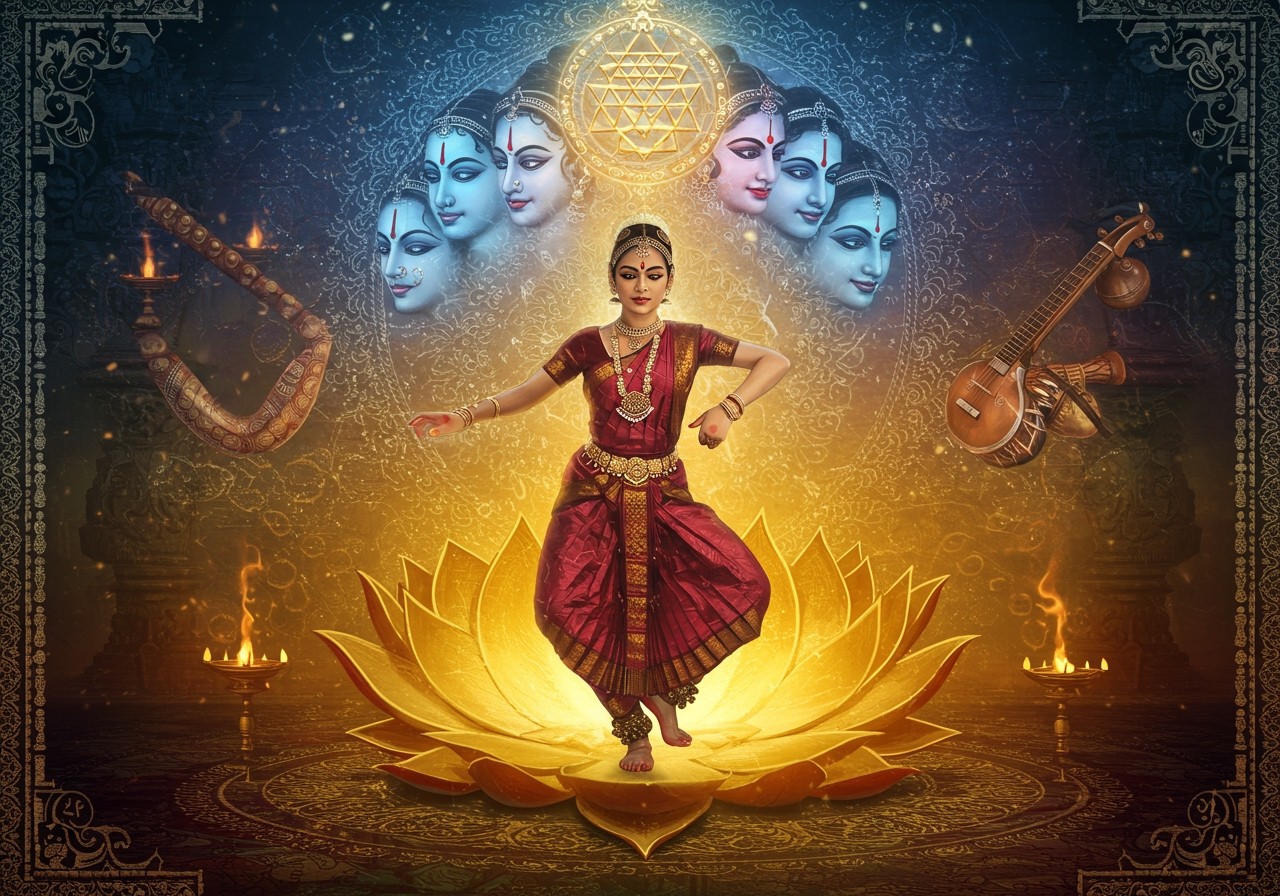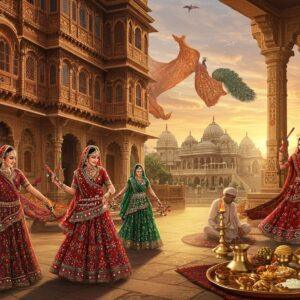
In Indian culture, aesthetics play a vital role in connecting with the divine. Rasa, an important concept, represents aesthetic flavors or sentiments that help us experience divinity. Understanding Rasa can deepen our appreciation for traditional practices and rituals. At poojn.in, we understand the deep significance of aesthetics in spiritual practices. That’s why we offer a wide selection of authentic puja items, deity idols, and spiritual décor to enhance your sacred space. Browse our collection of holy idols to find the perfect centerpiece for your home altar.
Understanding Rasa
Rasa is a central idea in Indian aesthetics, originating from classical Sanskrit literature. It helps evoke emotions and spiritual experiences, going beyond mere artistic enjoyment. The Natyashastra, an ancient treatise on dramaturgy, describes nine Rasas: Shringara (love), Hasya (laughter), Karuna (compassion), Raudra (anger), Veera (courage), Bhayanaka (fear), Bibhatsa (disgust), Adbhuta (wonder), and Shanta (peace). These Rasas are not just about superficial feelings; they carry deep spiritual meanings and help connect the observer to the divine, transforming art into a sacred experience. Explore our collection of holy books to delve deeper into the concept of Rasa and its significance.
The Spiritual Significance of Aesthetics
In our rich heritage, aesthetics and spirituality are beautifully interwoven. This connection transcends sensory pleasure; it’s a profound journey into the divine. Through aesthetics, we can transcend the mundane and experience the spiritual realm.
Aesthetics as a Pathway to Spiritual Experience
In India, art and aesthetics are not merely for entertainment; they hold a deep spiritual purpose. Witnessing a classical dance performance or gazing at an intricate painting evokes emotions that uplift our minds and spirits. These experiences can transport us to a state of flow, connecting us with something larger than ourselves. Aesthetic experiences contribute to spiritual well-being. By embracing beauty in our daily lives, we deepen our spiritual connection. This fosters a sense of peace and contentment, enriching our existence.
- Heightened Sensations: Engaging with art creates intense emotions and perceptions, leading to a sense of transcendence.
- Integration of Beauty: A deeper spiritual understanding allows us to integrate beauty into our lives, enhancing our aesthetic experiences.
Enhance your spiritual journey with our range of decorative items and handcrafted wooden masks.
The Nature of Beauty
In Indian tradition, beauty often reflects divine attributes. This concept is evident in the harmonious temple architecture or the delicate designs of traditional attire. This divine beauty shapes our understanding of true aesthetics. The theological significance of beauty links it with truth and goodness, which are essential aspects of spirituality. This deepens our cultural appreciation for art forms that convey spiritual messages, guiding us towards a richer understanding of our faith.
- Gift from God: Many believe that true beauty originates from the divine, reflecting God’s character.
- Reflection of God’s Attributes: Objective beauty is often seen as a manifestation of God’s qualities.
Art and Spirituality
Art in India serves as a gateway to spirituality. It is more than just visual appeal; it’s an exploration of unseen dimensions. Artists channel divine creativity, making art a reflection of eternal values and spiritual wisdom. Visual arts, especially, offer aesthetic reflections that delve into transcendence and meaning. Through symbolic imagery and storytelling, they explore spiritual themes, inviting us to contemplate life’s deeper truths. Discover our range of flammables for your puja rituals, including diyas, incense, and more.
- Source of Theology and Spirituality: True art acts as a source of spiritual insight and theological understanding. By engaging with art, we can deepen our connection with the divine.
- Exploration of the Unseen: Art delves into the unseen aspects of life, using imagination and symbolism to express spiritual realities. This allows us to explore realms beyond the physical.
Distinctions and Considerations
While aesthetic and religious experiences are distinct, they often intertwine in Indian rituals. Aesthetic elements like the sound of bells or the fragrance of incense heighten the spiritual depth of religious practices. Discerning true beauty becomes crucial in this context. It’s not just about sensory pleasure but about glorifying the divine. True beauty uplifts our spirits, aligning with our cultural values and traditions. Find authentic puja utensils to enhance your spiritual practices.
- Aesthetic vs. Religious Experience: While aesthetics focus on sensory perception, religious experiences are often driven by ideals and may not require external stimuli.
- True vs. False Beauty: Discerning true beauty—that which honors the divine—from superficial aesthetics is an important aspect of spiritual growth.
Embracing Aesthetics for Spiritual Growth
In the vibrant tapestry of Indian culture, aesthetics serve as a bridge to the divine. By engaging with art forms that resonate with spiritual themes, we discover a unique path to connect with our inner selves and the universe. Appreciating the beauty around us not only honors tradition but also invites spiritual wisdom into our lives. This journey through aesthetics is not just about appreciating art; it’s a celebration of the spiritual essence that enriches our existence, offering peace and fulfillment. Let us embrace this path, allowing it to guide us toward deeper understanding and harmony with the sacred. Complement your spiritual journey with traditional clothing, holy cosmetics, and sacred food offerings from poojn.in.
FAQs on Rasa and the Divine
What is the concept of Rasa in Indian art? Rasa is the essence or emotion that a work of art evokes in the viewer, fostering a deep connection with the art’s spiritual aspects.
How is Rasa connected to the Divine in Indian culture? Rasa connects to the Divine by evoking emotions that deepen our understanding and appreciation of sacred texts and depictions of deities, bringing us closer to the divine.
Why is Rasa important in depictions of deities? Rasa helps express the divine qualities and emotions of deities, making the spiritual experience more meaningful and immersive. Poojn.in offers a wide variety of deity idols crafted with attention to detail, capturing the essence of each divine form.
How does Rasa play a role in sacred texts? In sacred texts, Rasa conveys spiritual messages and emotions, allowing readers to connect with divine teachings on a deeper level. Explore our selection of holy books to enhance your understanding of these sacred texts.
Can Rasa be experienced in everyday life? Yes, Rasa can be experienced in everyday life through various forms of art, music, dance, and even nature, enriching our connection with the divine.
What are the different types of Rasa? The nine primary Rasas are Shringara (love), Hasya (laughter), Karuna (compassion), Raudra (anger), Veera (courage), Bhayanaka (fear), Bibhatsa (disgust), Adbhuta (wonder), and Shanta (peace).
How can Rasa enhance spiritual practices? Rasa enhances spiritual practices by deepening emotional responses, making rituals and meditations more engaging and fulfilling.
Is understanding Rasa necessary for appreciating Indian art? While not strictly necessary, understanding Rasa significantly enriches the appreciation of Indian art by revealing the deeper meanings and emotions intended by the artists.
Visit poojn.in today to explore our diverse collection of spiritual and cultural products!


